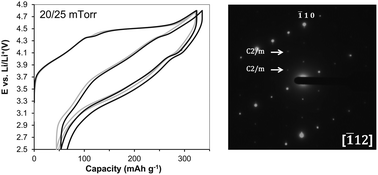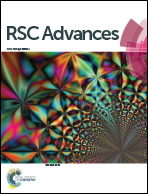Degradation mechanisms of lithium-rich nickel manganese cobalt oxide cathode thin films†
Abstract
This paper reports a method to prepare Li-rich NMC (Li1.2Mn0.55Ni0.15Co0.1O2) thin film cathodes for Li-ion batteries using RF magnetron sputtering and post-annealing in O2. Thin film cathodes with high reversible capacities (260 mA h g−1) and potential profiles similar to those of the powder material have been obtained. Structural and electrochemical studies show that the grown materials consist of a layered structure with trigonal symmetry in which Li/TM ordering is partially achieved. Using XPS we determine that the surface is comprised of Mn4+, Co3+ and Ni2+ cations inside an O2− framework. The loss mechanisms of these electrodes have been studied after 184 cycles. The data after cycling shows the absence of Li/TM ordering, confirming that Li2MnO3 activation is irreversible, while electron diffraction data indicates extensive structural modifications upon cycling. In addition, we identified that the surface chemistry is dominated by inorganic species (LiF, Lix′POy′Fz′, LixPFy), along with small amounts of organic species with C–O and O–C![[double bond, length as m-dash]](https://www.rsc.org/images/entities/char_e001.gif) O groups such as PEO, LiOR and RCO2Li. Moreover, XPS results indicate that Ni and Co migrate into the bulk while the reduction of Mn4+ into Mn3+ is clearly evidenced, as expected from the activation of Li2MnO3 domains and discharging to 2.5 V.
O groups such as PEO, LiOR and RCO2Li. Moreover, XPS results indicate that Ni and Co migrate into the bulk while the reduction of Mn4+ into Mn3+ is clearly evidenced, as expected from the activation of Li2MnO3 domains and discharging to 2.5 V.


 Please wait while we load your content...
Please wait while we load your content...